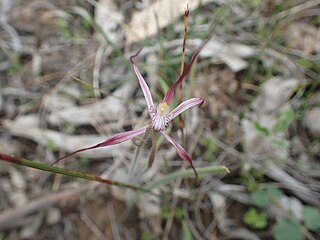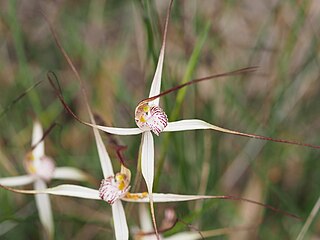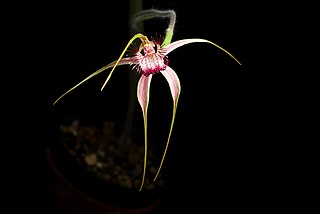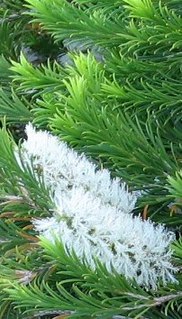
Caladenia gardneri, commonly known as the cherry spider orchid, is a species of orchid endemic to the south-west of Western Australia. It has a single, hairy leaf and up to three pale pink, sweetly scented flowers with a dark pinkish-red labellum.
Caladenia harringtoniae, commonly known as the pink spider orchid, is a species of orchid endemic to the south-west of Western Australia. It has a single, hairy leaf and up to three pale to deep pink flowers which have a cream-coloured labellum with a pink tip.

Caladenia huegelii, commonly known as the grand spider orchid is a species of orchid endemic to the south-west of Western Australia. It has a single, hairy leaf and up to three relatively large red, green and cream-coloured flowers which have "split-hairs" on the sides of the labellum.
Caladenia interjacens, commonly known as the Walpole spider orchid is a species of orchid endemic to the south-west of Western Australia. It has a single, hairy leaf and one or two pale pink and white flowers which lack the red tip on the labellum common to many other similar caladenias.
Caladenia lodgeana, commonly known as Lodge's spider orchid, is a species of orchid endemic to a restricted area of the south-west of Western Australia. It has a single, hairy leaf and up to three cream, red and pink flowers and a labellum which lacks the red tip common to many other similar caladenias.

Caladenia attingens subsp. attingens, commonly known as the forest mantis orchid or sneezing spider orchid, is a species of orchid endemic to the south-west of Western Australia. It is a relatively common orchid with a single erect, hairy leaf and one or two green, yellow and red flowers. It is similar to the fringed mantis orchid but has smaller flowers and has a more southerly distribution.

Caladenia microchila, commonly known as the western wispy spider orchid, is a species of orchid endemic to the south-west of Western Australia. It is relatively common orchid with a single erect, hairy leaf and up to three wispy white flowers with narrow lateral sepals and petals and a white labellum with red markings.

Caladenia nivalis, commonly known as the exotic spider orchid or crystalline spider orchid, is a species of orchid endemic to the south-west of Western Australia. This orchid is easily distinguished by its bright white to pale pink and red flowers and its narrow range in and near the Leeuwin-Naturaliste National Park.

Caladenia occidentalis, commonly known as the ruby spider orchid, is a species of orchid endemic to the south-west of Western Australia. It has a single erect, hairy leaf and one or two pinkish-red flowers with a white, red-striped labellum.
Caladenia pholcoidea subsp. augustensis, commonly known as the Augustus spider orchid, is a plant in the orchid family Orchidaceae and is endemic to the south-west of Western Australia. It is a rare orchid with a single hairy leaf and up to three mostly white flowers with long spreading petals and lateral sepals.

Caladenia polychroma, commonly known as the Joseph's spider orchid, is a species of orchid endemic to the south-west of Western Australia. It has a single erect, hairy leaf and one or two relatively large and colourful but smelly flowers.

Caladenia procera, commonly known as the Carbunup king spider orchid, is a species of orchid endemic to the south-west of Western Australia. It has a single erect, hairy leaf and up to four greenish-yellow and red flowers. It is one of the tallest and has amongst the largest flowers of the spider orchids.

Caladenia serotina, commonly known as the Christmas spider orchid, is a species of orchid endemic to the south-west of Western Australia. It has a single erect, hairy leaf and up to three white to cream-coloured and red flowers, although the relative amount of each is variable. It is one of the later-flowering spider orchids and occurs in the far south-west corner of the state.
Caladenia startiorum, commonly known as Starts' spider orchid, is a species of orchid endemic to the south-west of Western Australia. It has a single erect, hairy leaf and up to three pink flowers with a fringe of long teeth on the sides of the labellum and pinkish to brown club-like glandular tips on the sepals.

Caladenia straminichila, commonly known as the Tenterden yellow spider orchid, is a species of orchid endemic to the south-west of Western Australia. It has a single erect, hairy leaf and one or two pale yellow flowers which have a red-striped labellum with short teeth on its sides.

Caladenia thinicola, commonly known as the Scott River spider orchid, is a species of orchid endemic to the south-west of Western Australia. It has a single erect, hairy leaf and up to four yellowish-green and red flowers with a fringe of long teeth on the sides of the labellum and thick brown, club-like glandular tips on the sepals.
Caladenia viridescens, commonly known as the Dunsborough spider orchid, is a species of orchid endemic to the south-west of Western Australia. It has a single erect, hairy leaf and up to three pale greenish-yellow flowers with faint red or pink markings.
Caladenia wanosa, commonly known as the Kalbarri spider orchid, is a species of orchid endemic to the south-west of Western Australia. It has a single erect, hairy leaf and one or two cream-coloured flowers with red stripes. It is common but only in a restricted area of the state.

Caladenia williamsiae, commonly known as Judy's spider orchid, or Williams' spider orchid is a species of orchid endemic to the south-west of Western Australia. It is a rare species with a single relatively large, erect, hairy leaf and one or two delicate, greenish-yellow and red flowers. It is only known from a single population near Brookton.
Caladenia xantha, commonly known as the primrose spider orchid, is a species of orchid endemic to the south-west of Western Australia. It has a single erect, hairy leaf and up to three yellow flowers with a cream-coloured, brown-striped labellum.























